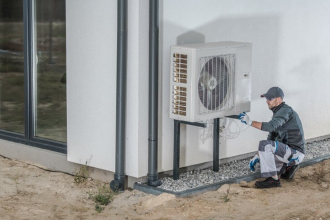Choosing the right roofing material for your home is a critical decision that affects not only the aesthetics of your abode but also its durability, maintenance requirements, and overall protection against the elements. With a plethora of options available on the market—ranging from traditional asphalt shingles and wood shakes to modern metal roofing and solar tiles—homeowners are faced with considering various factors such as climate, roof slope, and budget when making this choice. This guide aims to simplify the selection process by exploring the advantages and disadvantages of different roofing materials, thereby helping you make an informed decision that ensures your home remains safe and stylish for years to come.
1. Asphalt Shingles
Asphalt shingles are perhaps the most common roofing material found in homes across the U.S., prized for their cost-effectiveness and straightforward installation process. They come in a wide range of colors and styles, easily complementing various architectural designs. However, their lifespan is relatively shorter compared to other materials, typically lasting between 20 to 30 years with proper maintenance.
One notable advantage of asphalt shingles is their versatility. They can be installed on a broad array of roof shapes and sizes, making them a go-to choice for many homeowners. On the downside, they are susceptible to wind uplift and can suffer damage from extreme weather conditions, such as hailstorms and continuous high temperatures, which may necessitate more frequent repairs or replacements over their lifetime. There are many types of roof shingles and a professional roofing contractor can help you choose the type that best suits your needs. It’s essential to remember that not all asphalt shingles are created equal, and investing in high-quality shingles can significantly extend their lifespan.
2. Metal Roofing
Metal roofing has surged in popularity thanks to its durability, energy efficiency, and environmental sustainability. Capable of lasting 40 to 70 years, metal roofs are an excellent investment for homeowners seeking longevity from their roofing choice. They reflect solar radiant heat, which can reduce cooling costs in the warmer months, and are also highly resistant to adverse weather conditions.
Despite the higher initial cost compared to asphalt shingles, the longevity and low maintenance requirements of metal roofing can make it more cost-effective in the long run. Metal roofs are also available in a variety of styles and finishes, including options that mimic the look of traditional shingles, tiles, or wood shakes, offering both aesthetic flexibility and functional benefits.
3. Clay and Concrete Tiles
Clay and concrete tiles add a distinctive touch to homes, reflecting a range of architectural styles from Spanish and Mediterranean to contemporary. These materials are exceptionally durable, with a lifespan that can extend beyond 50 years. They are highly resistant to fire, rot, and insect damage, making them an ideal choice for areas prone to such concerns.
However, both clay and concrete tiles are significantly heavier than other roofing materials, requiring additional structural support to ensure the roof can bear the weight. This can increase the complexity and cost of installation. Additionally, while they offer excellent durability, they are also more brittle and can break when walked on, necessitating careful maintenance and inspection routines.
4. Wood Shakes and Shingles
Wood shakes and shingles offer a natural, rustic aesthetic that complements landscapes and architectural styles favoring organic materials. They provide better insulation than many other roofing materials and are made from renewable resources, appealing to environmentally conscious homeowners. Over time, they develop a distinctive gray or silver patina that many find appealing.
The primary drawback of wood shakes and shingles is their maintenance requirement. They need regular treatment to prevent moisture absorption, warping, and damage from insects or mold. Additionally, in areas prone to wildfires, they may not be the best choice unless treated with fire-resistant chemicals, which can add to their overall cost and maintenance needs.
5. Solar Tiles
Integrating solar technology into roofing materials, solar tiles offer homeowners the opportunity to generate their own electricity, potentially reducing energy bills. They are designed to blend seamlessly with the rest of the roofing material, providing an aesthetically pleasing alternative to traditional solar panel installations.
The main consideration for solar tiles is their cost, which is significantly higher than that of standard roofing materials. However, the potential for energy savings over time, combined with state and federal incentives, can mitigate the initial investment. Additionally, it’s important to evaluate the solar potential of your home, including the orientation and angle of your roof, to ensure that installing solar tiles will provide an efficient energy source.
Choosing the right roofing material for your home requires careful consideration of various factors. It’s important to research and consult with a professional roofing contractor to determine which option best suits your needs, budget, and climate conditions. By making an informed decision, you can ensure that your home remains safe, stylish, and functional for years to come. With the right roofing material in place, you can enjoy peace of mind and protect your investment for the long term. So take your time, consider all options, and choose wisely when it comes to selecting the perfect roofing material for your home.














